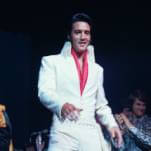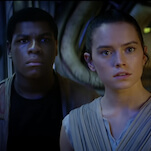From the start, the cover makes it clear that this issue is going to continue incorporating the Marvel movie universe into 616 continuity, with a Samuel L. Jackson-looking Nick Fury, Jr. tossing superhero dossiers at the reader. And no, that isn’t Ultimate Fury. For anyone who didn’t read Battle Scars, Nick Fury has a secret son with a striking resemblance to Samuel L. Jackson, who took his dad’s place after Fury, Sr. retired. It was one of Marvel’s most egregious attempts at making the comics align with the films, but the damage has been done and it’s time to more forward. (Nick Fury, Sr. will probably still show up at some point to save the day at the last minute, as the old coot is wont to do.)
Spencer and Ross’ framing sequence follows Fury with agents Maria Hill and Phil Coulson (alive and well in the comics, and soon to be alive and well on the S.H.I.E.L.D. television series) as they try to squeeze information from a man with ominous messages from the future. Spencer captures the chemistry between these characters that has made them popular onscreen, particularly with Coulson’s cheeky comic relief, and Ross capably illustrates what is primarily a talking-heads story. Ross’ style has become reminiscent of artists like Y: The Last Man’s Pia Guerra and Goran Parlov, detailed and expressive but still relatively loose, especially when compared to someone like Steve McNiven, who brings big-budget Hollywood flair to every page of the Guardians prologue.
Peter “Starlord” Quill’s origin spanned two pages in Marvel Preview #4 in 1976, so naturally Brian Michael Bendis will be stretching it out considerably when he takes over Guardians Of The Galaxy. Decompression doesn’t have to be a bad thing, though, and in this eight-page prologue, Bendis focuses on the specific moment when Quill’s life changed, creating a suspenseful science-fiction thriller with a cliffhanger that makes the series’ February 27 launch feel too far away. McNiven continues his transition into a timelier Travis Charest as he meticulously renders Bendis’ script, combining rural imagery with science-fiction wonder to give the story an early Spielberg tone. Marvel’s teasing of a book that doesn’t come out for four months shows how smart Marvel Now!’s publishing schedule and promotional team are. The gradual release of the titles allows them to spotlight a smaller group of first issues each month leading up to the relaunch, building anticipation for each individual title rather than having some books get lost in an onslaught of new debuts.
Nova also doesn’t debut until the end of February, but this short story does a lot to build confidence for the future of the series, especially considering Loeb’s shaky track record at Marvel of late. Sam Alexander, the new Nova, appears on Disney XD’s Ultimate Spider-Man, and his story in Point One is a refreshingly all-ages done-in-one that pits him against old Nova foe Diamondhead for an aerial brawl above Monument Valley, Utah. It’s a fun, charming story, and McGuinness’ clean, energetic art emphasizes how young and unevenly matched Sam is compared to his enemy. A vulnerable novice is a nice departure from Loeb and McGuinness’ absurdly powerful Red Hulk, and Loeb keeps the story grounded, ending with Diamondhead asking Nova if he can get a ride to the next town, since his jet pack broke. The new Nova’s brief appearances in Avengers Vs. X-Men didn’t offer much of the new character’s personality and outlook, but there’s a lot of potential for him after these eight pages.
Speaking of potential, last year’s Vengeance miniseries was one of Marvel’s best titles that didn’t get the attention it deserved, but one of its standout characters lives on in the Young Avengers prologue, which reunites the Phonogram team of Gillen and McKelvie. Point One’s second strongest installment peeks in on a meeting between Vengeance’s Miss America and Kid Loki on Earth-212, as they share Korean barbecue while discussing the threat of Billy “Wiccan” Kaplan, son of the Scarlet Witch. “Discuss” meaning Loki explains while Miss America grabs him by the throat and punches him across the restaurant. There’s so much personality in these pages, from Gillen’s quirky dialogue to McKelvie’s character design, which turns a booty-shorts/hoodie/denim jacket combo into a hip modern superhero combo.
The first panel of Miss America flying over the New York skyline is a breathtaking shot, with McKelvie positioning the angle to emphasize just how high America is soaring, and background artist Mike Norton rendering the city in intense detail. And when the fight breaks out, McKelvie plays with the layouts to recreate the chaos of the action in the arrangement of the panels. After America grabs Loki by the throat, an assortment of panels showing other patrons’ reactions and various environmental shots are scattered over the main action, and when she slams his head into the table, McKelvie arranges panels on a curve that mimics the motion. With both the Nova and Young Avengers stories, Point One emphasizes just how cool it would be to have youth and superpowers. It makes a stark contrast with DC’s Young Justice line of titles, a bleak, dreary mess that has become incomprehensible after only 13 months. Both stories are inviting to new readers, with the Young Avengers tale literally ending with Loki handing the reader an application to join the team. In one of the best uses of Marvel’s AR app, scanning that last panel pulls up a video of Gillen, McKelvie, and editor Lauren Sankovitch handing out fliers for Young Avengers on the streets of London the day the book was announced. It isn’t essential viewing by any means, but it does show how dedicated this team is to getting people interested in their book.
One Young Avenger who won’t be appearing in the upcoming series is Cassie “Stature” Lang, who was killed by Dr. Doom at the end of Young Avengers: The Children’s Crusade. Matt Fraction and Michael Allred look at the impact Cassie’s death has had on her father Scott in their Ant-Man story, the standout chapter of Point One that cements FF as one of the most anticipated books of Marvel Now! Matt Fraction has been on an incredible streak recently (for more awesome Fraction superheroics, see this week’s Hawkeye #3 and The Mighty Thor #21), and this Scott Lang solo tale is an exquisite balance of silly superhero action-comedy and devastating emotional drama, revealing a man trying to escape his grief by embracing the things that once made him happy. Fraction takes advantage of Lang’s microscopic size to turn an eyelash mite into a monstrous opponent, and Michael Allred brings in a Kirby-esque flair as he illustrates the various tiny dangers Ant-Man encounters as he sneaks into the Latverian embassy.
The Ant-Man story begins with some meta commentary: first, a panel of Ant-Man in costume saying, “Hey kids, it’s Ant-Man,” followed by a shot of plainclothes Scott Lang holding up Marcel Duchamp’s L.H.O.O.Q. and saying, “Hey, look. It’s art.” He’s talking to his daughter in a flashback to Cassie’s childhood, explaining to her that art is whatever somebody says it is, and sometimes it’s silly. Cassie responds by drawing two pink moustaches and goatees on a photo of her with her dad, with “I love you Daddy” written in beginner’s cursive. Fraction and Allred have been known to embrace the oddball, but that doesn’t sacrifice the artistic merit of their work, especially considering the profound effect of their “silly” story’s conclusion. As he reaches his destination inside the embassy, Ant-Man pulls out a pink marker and draws a pink moustache and goatee on Doom’s self-portrait, along with the word “LOOK.” It’s goofy but dramatically effective, a heartwarming love letter to a dead daughter that also serves as a promise of future vengeance.
Another damaged hero begins to repair himself in Dennis Hopeless and Gabriel Hernandez Walta’s Forge solo story, which takes a unique look at Forge’s mutant ability to fix anything. Insane and abandoned in the ruins of Wundagore Mountain after the event of Warren Ellis’ Astonishing X-Men, Forge discovers a machine full of parts that don’t fit together and don’t seem to have any obvious purpose. That machine is his brain, which Forge is able to put back together with the help of a damaged Cable, who would like the mutant builder’s assistance in return. It’s a brilliant use of Forge’s power, and Walta’s artwork sets an appropriately dystopian tone in his artwork, but it would have been nice to see Hopeless’ Cable And X-Force artist Salvador Larocca pencil the story.
Hopeless is one of the relative newcomers getting a big push by Marvel Now!, and the focus on Forge’s character suggests good things for the future of Cable And X-Force. That said, Hopeless’ other Marvel Now! title, Avengers Arena, remains one of the most divisive, distressing announcements of the relaunch. The book pits Marvel’s teen heroes (including members of the Runaways and Avengers Academy) against each other in Arcade’s Murderworld, which on paper seems like a cheap rip-off of The Hunger Games. With luck, the actual book will rise above the questionable concept, and Hopeless’ Point One story shows that he can keep the integrity of these characters while taking them in new directions. That’s a quality on display throughout Marvel Now! Point One, which boldly moves the Marvel Universe forward without forgetting what came before.


![HBO teases new Euphoria, Larry David, and much more in 2026 sizzle reel [Updated]](https://img.pastemagazine.com/wp-content/avuploads/2025/12/12100344/MixCollage-12-Dec-2025-09-56-AM-9137.jpg)





































